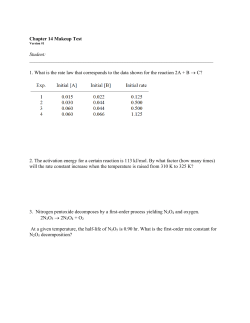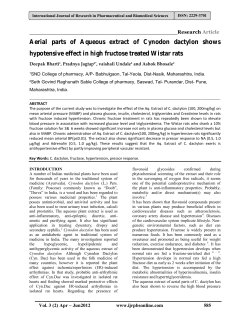
Document 69340
Low fructose diet for children What is fructose? Fructose (sometimes called fruit sugar) is a natural sugar that is mainly found in fruits and honey, with smaller amounts found in some vegetables. It is also present in some processed foods. What is fructose intolerance? Fructose intolerance occurs when the body is unable to absorb fructose well. A common symptom of fructose intolerance is diarrhoea. Some children also experience abdominal pain, bloating, wind and irritability. The diagnosis of fructose intolerance should be confirmed by a breath hydrogen test. Fructose intolerance should not be confused with ‘Hereditary Fructose Intolerance’ - a much more serious condition caused by a liver defect. This information sheet is not intended for children with ‘Hereditary Fructose Intolerance’. Treatment Fructose intolerance is treated by lowering the amount of fructose in the diet. There are four ways to reduce the symptoms of fructose intolerance: > Reduce the total amount of fructose in the diet. > Eat fructose containing foods as part of a meal rather than a snack. > Choose foods that have a higher glucose to fructose ratio (more glucose in the food than fructose) as glucose helps the body absorb fructose. > Add free glucose (dextrose) to foods. This will help to improve the glucose to fructose ratio and will help the body absorb fructose. Tolerance Fructose does not need to be completely removed from the diet. Tolerance of fructose will vary greatly between children. Many children will tolerate small amounts of a high fructose food without symptoms however if large amounts are eaten symptoms may reappear. Vitamin C Fruits and vegetables provide most of our vitamin C. If your child is not eating many fruits and vegetables they may need a vitamin C supplement. Discuss this with your dietitian. Medications Some medications contain fructose and should be checked before giving to your child. Fructose content of fruits and vegetables The following tables sort fruits and vegetables into four groups: Low fructose Fruit and vegetables that contain low amounts of fructose and can be eaten freely. Moderate fructose Fruit and vegetables that contain moderate amounts of fructose. Initially when starting a low fructose diet this group should be avoided. Once symptoms resolved you can then challenge with small amounts from this group. High fructose Fruit and vegetables that contain high amounts of fructose. Initially when starting a low fructose diet this group should be avoided. Once symptoms resolved you can then challenge with small amounts from this group. Very high fructose Fruit and vegetables that contain very high amounts of fructose. This group should be avoided. Fruit and vegetables that have a good glucose to fructose ratio will be better tolerated within each group. Low fructose (less than 1%) Low fructose fruit and vegetables with good glucose/fructose ratio Other low fructose fruit and vegetables > apricots (raw) > chinese cabbage > artichoke > ginger > avocado > cucumber > asparagus > green bean > brussel sprouts > green capsicum > bean sprouts > potato > cauliflower > green chilli > beetroot (fresh) > pumpkin (butternut) > grapefruit > green pea > broad bean > silverbeet > lemons > lettuce (common) > broccoli > snow pea > limes > mushroom > celeriac > rhubarb > parsley > cranberries > celery > parsnip > endive > spinach > sweetcorn > tamarillo > watercress > radish > zucchini Moderate fructose (1-2.5%) Moderate fructose fruit and vegetables with good glucose/fructose ratio Other moderate fructose fruit and vegetables > apricots (canned) > banana capsicum > raspberries > beetroot (canned) > peaches (fresh or > blackcurrants > red capsicum > cabbage (white/savoy) > plum > chives > red chilli > carrot > green olive > grapefruit > shallot > eggplant > pumpkin (queensland > guava (raw) > strawberries > fennel tinned) > honeydew melon > tangelos > nectarine > squash > marrow > tomato (raw) > passionfruit > swede > mulberry > turnip > sweet potato > orange > watermelon > turnip > pineapple (raw) (fresh/tinned) blue & golden nugget) High fructose (2.5-5%) High fructose fruit with good glucose/fructose ratio Other high fructose fruit > banana > mandarin (canned in syrup) > loquat > blackberry (raw/frozen) > paw paw > mandarin > > pineapple (canned in natural juice) > mango > > > cherry (raw) fig (raw) jack fruit kiwi fruit > rambutan > rockmelon > star fruit Very high fructose (greater than 5%) Very high fructose fruit with good glucose/fructose ratio Other very high fructose fruit > blueberries > tinned berries in syrup > gherkin > custard apple (frozen/fresh) > lychee > tomato concentrate products (eg. tomato paste) (cherries, raspberries, strawberries, blueberries) > all dried fruit (figs, apricots, dates, prunes, sultanas, raisins, currants) > grape > apple > persimmon > nashi pear > pickled onion > pear > pomegranate > quince > tinned dark plum in syrup drained Onion, leek, garlic and legumes Onion, leek, garlic and legumes contain low to moderate amounts of fructose but often can cause bloating and discomfort in children with fructose intolerance. These foods are best avoided initially when starting a low fructose diet. Once symptoms of fructose intolerance (eg. bloating, diarrhoea) have improved they can then be reintroduced in small amounts as tolerated. Sugar and sugar alcohols Some sugars contain high amounts of fructose and are best avoided initially on a low fructose diet. Sugar alcohols are food additives used as artificial sweeteners in some products. Sometimes children with fructose intolerance can’t tolerate sugar alcohols. If sugar alcohols cause problems for your child (eg. bloating, diarrhoea, abdominal pain) they may need to avoid them. Sugars and sugar alcohols to limit > honey > Palm sugar > Xylitol > brown sugar > Sorbitol > Erithitol > caramel > Mannitol > Lactitol > fructose > Isomalt > Splenda > high fructose corn syrup > Maltitol > golden syrup Commercial foods Some commercial foods will contain large amounts of fructose due to ingredients used. Tolerance will vary - some children will need to avoid them while others may tolerate small amounts of them with no problems. Examples of foods that may contain large amounts of fructose include: Food product Examples and advice concentrated tomato products > tomato paste, tomato pasta sauces, tomato sauce > use these products sparingly or use fresh tomato or canned chopped tomatoes in small amounts instead. > choose cream based pasta sauces instead of tomato based foods with added high fructose sugars or sugar alcohols > see table of high fructose sugars to avoid on previous foods with added fruit (especially dried fruit) > breads, muesli bars, breakfast cereals and yoghurts with page of this booklet. added fruit. > choose breads, muesli bars, breakfast cereals and yoghurts without added fruit. > fruit juice (except cranberry), cordials with added juice. drinks based on fruit > choose water and milk as drinks sugar free confectionary: > often contain sugar alcohols – see table of sugar alcohols to avoid on previous page of this booklet. > sweet and sour, BBQ, sweet chilli, hoi sin and plum. Asian sauces Adding glucose Glucose powder (often called dextrose powder) can be added to high fructose foods to help the body absorb fructose. It is available in supermarkets and chemists (eg. “Glucodin”). Cooking If you are cooking with ingredients that contain fructose (eg. dried fruit) try using glucose powder in your recipe instead of other sugar. Other sugars are sweeter than glucose powder – use the following conversions: 1 tbsp sugar use 1½ tbsp glucose powder ½ cup sugar use ¾ cup glucose powder 1 cup sugar use 1½ cups glucose powder Food product information contained in this resource was up to date at the time of revision. If you are not sure about a food, check with the manufacturer. Produced by Women’s and Children’s Health Network Nutrition Department 72 King William Road North Adelaide SA 5006 © Department of Health, Government of South Australia. All rights reserved. Revised February 2012
© Copyright 2025












